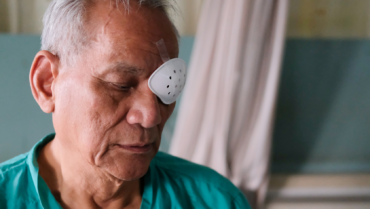
Safety and Efficacy of Topical vs Intracanalicular Corticosteroids for the Prevention of Postoperative Inflammation After Cataract Surgery
Lu AQ, Rizk M, O’Rourke T, et al1
Industry support: Supported in part by Ocular Therapeutix through an investigator-initiated trial
ABSTRACT SUMMARY
A retrospective consecutive case series compared the safety and efficacy of topical prednisolone and an intracanalicular dexamethasone ophthalmic insert 0.4 mg (Dextenza, Ocular Therapeutix) for the prevention of postoperative inflammation after cataract surgery. The study included 262 eyes of 262 patients who underwent phaco cataract surgery and received either topical prednisolone acetate or intracanalicular dexamethasone for the management of postoperative inflammation. Endpoints were measured at 1 week and the final postoperative visit 4 to 16 weeks after surgery.
Study in Brief
A retrospective consecutive case series found no significant differences between the rates of breakthrough inflammation or in IOP elevation after cataract surgery in eyes receiving topical prednisolone drops or an intracanalicular dexamethasone ophthalmic insert 0.4 mg (Dextenza, Ocular Therapeutix).
WHY IT MATTERS
The study suggests that intracanalicular dexamethasone is a safe and effective alternative to traditional topical steroid drops after cataract surgery.
The rate of breakthrough inflammation was significantly higher in the intracanalicular group at the 1-week visit (46.2% vs 31.9%; P = .03) but not at the final postoperative visit (9.2% vs 6.9%; P = .50). Neither the rate of breakthrough inflammation requiring treatment nor IOP elevation was significantly different between groups at the final postoperative visit. Reported pain level and rates of cystoid macular edema were also similar between the two groups.
DISCUSSION
The current study is the first to compare intracanalicular dexamethasone directly to topical steroids after cataract surgery. Importantly, the study showed that the safety and efficacy of the two approaches were similar. The rates of breakthrough inflammation reported for both groups were similar to those reported by previous studies. In the current study, more than half of the patients who experienced breakthrough inflammation admitted poor compliance or anxiety over administering drops.
It is worth noting that the measurement of the primary endpoint occurred anytime between 4 and 16 weeks postoperatively. A previous pharmacokinetic study in canines found that a 0.4-mg dexamethasone depot in the canaliculus was undetectable 28 days after administration.2 Further investigation in humans or a masked randomized controlled trial with specific timing of postoperative examinations would be worthwhile.
The investigators of the current study noted that patients should be counseled on possible epiphora in the postoperative period, but this was not evaluated specifically in the study. A recent, smaller study reported that two of 24 patients experienced canalicular obstruction with an intracanalicular dexamethasone ophthalmic insert.3 Additional studies should be pursued to determine the association between the insert and postoperative epiphora.
Intracameral Dexamethasone 9% vs Prednisolone Acetate 1% in Controlling Postoperative Pain and Inflammation in Patients Undergoing Cataract Surgery
Hovanesian JA, Donnenfeld ED4
Industry support: Supported by a grant from EyePoint Pharmaceuticals
ABSTRACT SUMMARY
An open-label, randomized, self-controlled, prospective study compared patient preferences for a one- or three-drop regimen of topical medication after cataract surgery. The study included 60 eyes of 30 patients who underwent phaco cataract surgery. One eye was randomly assigned to the intracameral delivery of dexamethasone 9% (Dexycu, EyePoint Pharmaceuticals) and 500 µg of moxifloxacin 0.5% and a one-drop regimen of topical bromfenac 0.07% for 30 days. The contralateral eye did not receive an intracameral injection and was assigned to a three-drop regimen of topical moxifloxacin 0.5% four times per day for 7 days, bromfenac 0.07% daily for 30 days, and prednisolone acetate 1% four times per day for 14 days and then twice daily for 16 days postoperatively.
Study in Brief
An open-label, prospective, randomized, self-controlled study found that patients preferred a one-drop regimen of topical bromfenac with intracameral dexamethasone 9% (Dexycu, EyePoint Pharmaceuticals) and moxifloxacin to a three-drop regimen after cataract surgery.
WHY IT MATTERS
The study reinforces earlier research showing that patients prefer and exhibit better adherence to a simpler postoperative drop regimen. The safety and clinical outcomes between the contralateral eyes were similar.
Most patients (96.6%) preferred the one-drop regimen, primarily because of the ease of use. Patients reported that the one-drop regimen interfered less with activities such as driving at night and reading. The out-of-pocket cost of the one-drop regimen was also nearly $100 less ($40.90 vs $139.20).
There were no statistically significant differences between the groups in terms of macular thickness, refractive error, or corrected distance visual acuity at day 28. There were no significant differences in IOP between the groups at day 1 or week 1, 2, or 4. The summed ocular inflammation score was significantly lower at day 7 for eyes assigned to the one-drop regimen.
DISCUSSION
The current study provides additional evidence of the safety and efficacy of intracameral dexamethasone 9% for the control of inflammation after cataract surgery. The research also adds to the literature by examining the patient perspective on postoperative drop use. It is not surprising that patients preferred to instill fewer drops postoperatively because previous studies demonstrated that most patients do not administer eye drops properly.5
The cost analysis in the current study found that the one-drop regimen was associated with a significantly lower out-of-pocket cost for patients. The investigators acknowledged, however, that cost savings may be limited by insurance coverage. The actual cost of intracameral dexamethasone 9% to the patient was not reported. Even if insurance covers the drug, there is a cost to the health care system and society. Cataract surgery has been shown to be highly cost-effective, but prior studies did not include the cost of newer intraoperative drugs.6 Future studies should explore the cost of no-drop alternatives in more detail.
1. Lu AQ, Risk M, O’Rourke T, et al. Safety and efficacy of topical vs intracanalicular corticosteroids for the prevention of postoperative inflammation after cataract surgery. J Cataract Refract Surg. 2022;48(11):1242-1247.
2. Blizzard C, Desai A, Driscoll A. Pharmacokinetic studies of sustained-release depot of dexamethasone in beagle dogs. J Ocul Pharmacol Ther. 2016;32(9):595-600.
3. Fram N, Alsetri H, Shiler O, Paterno PJ, Cabang J. Retrospective study of a sustained-release intracanalicular dexamethasone insert for treatment of ocular inflammation after cataract and corneal surgery. Clin Ophthalmol. 2022;16:4065-4074.
4. Hovanesian JA, Donnenfeld ED. Intracameral dexamethasone 9% vs prednisolone acetate 1% in controlling postoperative pain and inflammation in patients undergoing cataract surgery. J Cataract Refract Surg. 2022;48(8):906-911.
5. An JA, Kasner O, Samek DA, Lévesque V. Evaluation of eyedrop administration by inexperienced patients after cataract surgery. J Cataract Refract Surg. 2014;40(11):1857-1861.
6. Brown GC, Brown MM, Busbee BG. Cost-utility analysis of cataract surgery in the United States for the year 2018. J Cataract Refract Surg. 2019;45(7):927-938.


